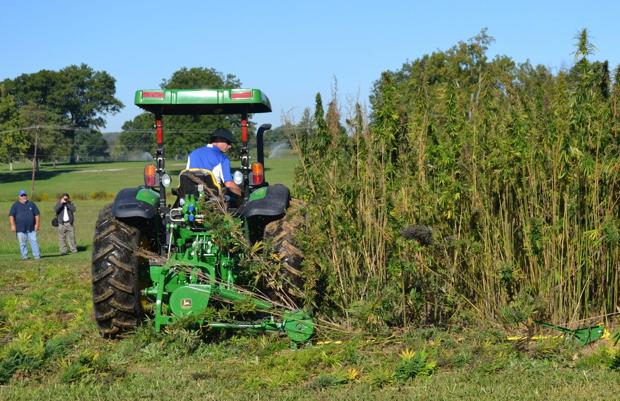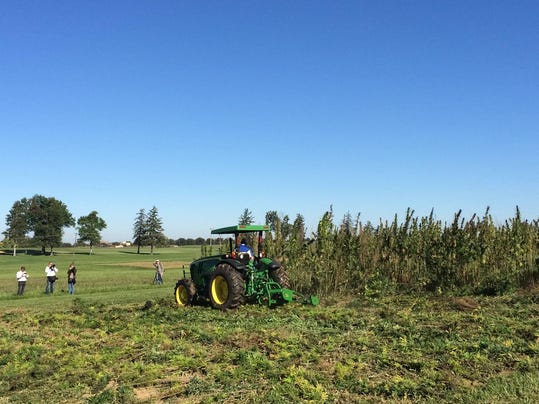by Tim Thornberry
Source: bizlex.com
Local, state and national advocates for industrial hemp recently gathered at the University of Kentucky Research Farm to experience the crop firsthand and celebrate Hemp History Week. In its second year of research, the Kentucky hemp movement is leading the way nationally to restored production.
Eric Steenstra, executive director of the Hemp Industries Association, served as emcee of the event and noted Kentucky’s rich history with the crop.
“Kentucky has an incredible, long history of growing hemp and was, at one time, the center of the hemp industry,” he said. “It’s certainly taking the lead now thanks to Commissioner [James] Comer from the Kentucky Department of Agriculture, who was really the one who championed bringing back hemp and pushed it through the legislature against some stiff opposition.”
Adam Watson, who heads up the industrial hemp program at KDA, addressed the gathering and talked about moving hemp forward from just research production to the real thing.
“In some instances, hemp is still very much an oddity and not something everyone is familiar with. But with the work from last year continuing this year, we’re hoping to move hemp more to the realm of just another agriculture commodity because, in truth, that’s what it is,” he said.
Watson added that the industry is in an educational stage, getting the word out as to what hemp is and what it isn’t.
“But we hope to get to the point that if you want to know about hemp, talk to a hemp farmer or talk to your county ag agent,” he said. “They are the ones that can fill you in because for us, hemp should be considered and regarded as just an agricultural crop.”
Unfortunately, the federal government has not come to that realization yet, as hemp remains on the controlled substances list.
Watson believes the day is getting closer to when that will no longer be the case.
“I think the reality of industrial hemp is, if we can show and prove it has a spot in the modern farm economy, if we’re successful with these research pilot programs, that will be the greatest step toward having action at a federal level,” he said.
That may still take time as research continues, but proponents feel confident. Andrew Graves represents the seventh generation in his family to be involved in hemp production. He is CEO of Atelo Holdings, a holding company for three hemp businesses. An experienced tobacco grower, Graves said it is an appropriate time to have another crop.
“What’s most important is we are doing real on-farm research that’s valuable to longterm growing of this young industry,” he said. “Farmers can now go out and touch and feel it, bring their friends in to look at it. We can talk about it freely, and you don’t have to demonize it in any way. It’s out in the open.”
Graves added that he sees a new generation getting involved in hemp production and feels they see long-term opportunities in this crop.
Advocates for industrial hemp, young and otherwise, are hopeful current research efforts will help those opportunities be realized.
Having gained research funding this year, UK expanded its study of the crop, adding a graduate assistant for the hemp project and increasing the number of research acres planted to about 30 acres.
David Williams, UK College of Agriculture, Food and Environment agronomist and co-project lead for the hemp research, said much has been learned here from looking at research and production in other countries where industrial hemp is legal.
“We are relying on that information to guide our own research activities here,” he said. “I think it is pretty well known what the main harvestable commodities are from hemp, so I don’t necessarily expect that we’re going to discover new uses for the plant, at least not immediately. But I don’t know of any other species that is propagated and harvested for such varied purposes.”
Among the uses, Williams points to fiber production and cannabinoid research as two areas of great interest. Cannabinoids are extracts derived from industrial hemp that are often used in medical research.
Some of that cannabinoid research, which until now has been conducted indoors, is going outdoors at UK, something that may hold the key to it being a potential replacement crop for tobacco producers.
“I’ll underline and bold that word ‘potential,’ ” Williams cautioned. “If a tobacco production model yielded more cannabinoids than a direct-seeding model, it could be a potentially wonderful thing for central Kentucky farmers.”
Leah Black, a graduate research assistant and recent Auburn University graduate with a degree in agronomy and soils, is aiding the research at UK.
After visiting Williams last October, she discovered a few weeks ago she would be coming to Kentucky to assist in the program.
“My master’s degree will be in integrated plant and soil science with a focus on hemp research with my projects,” she said.
Black has long had an interest in industrial hemp and worked most of her last year at Auburn to find a program like the one at UK.
“I was over the moon when Dr. Williams approached me with an assistantship offer to work on hemp,” she said.
Black is among a growing number of young people showing an interest in hemp. She said it’s important to get hard science behind it to help legitimize the industry.
“I feel we would be making a horrible mistake if we were to neglect a crop with so many diverse uses,” said Black.








